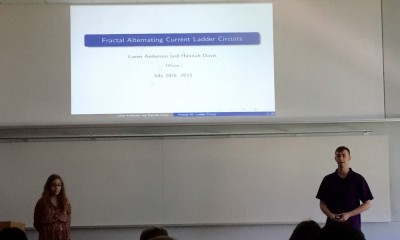Group Members
Loren Anderson, Aubrey Coffey, Hannah Davis, Lee Fisher, Madeline Hansalik, Stephen Loew
Supervisors
Alexander Teplyaev, Luke Rogers, Antoni Brzoska, Ulysses Andrews
Overview
In this project, Feynman’s analysis of an infinite ladder circuit is extended to fractal circuits, in particular, a Sierpinski Ladder circuit and two variants of a Hanoi circuit. These circuits are constructed by taking the limit of graph approximations with inductors and capacitors placed along edges in a well-defined manner. Inductors, capacitors and resistors all contribute to the impedance within a circuit; but whereas a resistor imparts a real impedance, inductors and capacitors impart a purely imaginary impedance.
For each circuit, the following was accomplished. First, the net impedance between certain boundary points of the circuit was computed. Second, the filter conditions for each circuit were found. A circuit becomes a filter when the net impedance between boundary vertices has a positive real part! Third, it was proved that these impedances can be obtained by placing a small positive resistance epsilon on each edge of the graph approximations, finding the limiting impedance between the boundary vertices, and then taking epsilon to zero. Finally, the construction of harmonic functions on these circuits was outlined.